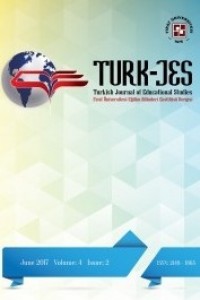Abstract
Günümüzde eğitim araştırmalarında sıklıkla kullanılan nitel araştırmalar insanların kendi deneyimlerini nasıl yorumladıkları, kendi dünyalarını nasıl yapılandırdıkları ve deneyimlerine ne anlamlar yükledikleri ile ilgilenir. Nitel araştırmaların kendilerine özgü özellikleri vardır. Nitel araştırmalar naturalistik, tanımlayıcı, süreçle ilgili, tümevarımsal ve anlamın önemli olduğu çalışmalardır. Bu özelliklerinden dolayı nitel araştırmalarda yanlış algılamayı ve sonuçların geçersizliğini en aza indirmek için üçgenleme kullanılır. Üçgenleme, doğruluğu arttırmak için bir şeye çoklu bakış açısı ile bakmak anlamına gelir. Bu bağlamda nitel araştırmalarda veri üçgenlemesi olarak odak grup görüşmesi, bireysel görüşme ve gözlem kullanılabilir.Odak grup görüşmeleri araştırmacının süreç içerisindeki sosyal etkileşimleri görmesini sağlar.Odak gruplar belirli bir şekilde yapılandırılmış, iyi tanımlanmış hedefleri olan grup görüşmeleridir. Görüşme ise bir kişinin bilgi edinmek amacı ile diğerine soru yöneltmesidir. Görüşme katılımcıların kendi kelimeleri ile tanımlayıcı veri elde etmek için kullanılır. Böylece, araştırmacı katılımcıların kendi dünyalarını nasıl yorumladıkları ile ilgili iç görü geliştirebilir. Bu çalışmada veri üçgenlemesi olarak kullanılan son yöntem olan gözlem yoluyla araştırmacı katılımcıların günlük uygulamalarını belgeleyerek, onların deneyimlerini daha iyi anlamaya çalışır.Bu çalışmanın amacı, nitel araştırmalarda kullanılan odak grup görüşmeleri, bireysel görüşmeler ve gözlemleri tanıtmak ve veri üçgenlemesi olarak nasıl kullanıldığını betimlemektir.
References
- 1. Albrecht, T. L., Johnson, G. M. & Walther, J. B. (1998). Understanding communication processes in focus groups, David L. Morgan (Ed) (pp. 51-62). Successful focus groups: Advancing state of the art. Newbury Park, Sage Publications.
- 2. Akar, H. (2016). Durum çalışması, Ahmet Saban ve Ali Ersoy (Ed.) (ss. 139-176). Eğitimde nitel araştırma desenleri. Ankara, Anı Yayıncılık.
- 3. Atkins, L. &Wallace, S. (2012). Qualitative research in education. London, Sage Publications.
- 4. Bal, H. (2016). Nitel araştırma yöntem ve teknikleri (Uygulamalı örnekli). (1. Basım). İstanbul, Sentez Yayınları.
- 5. Bogdan, R. C. & Biklen, S. K. (1998). Qualitative research for education: An introduction to theory and methods (3rd Edition). Boston, Allyn and Bacon.
- 6. Denzin, N. K. ve Lincoln, Y. S. (1998). Introduction: Entering the field of qualitative research, Norman K. Denzin and Yvonna S. Lincoln (Ed.) (pp. 1-35). Strategies of qualitative inquiry. Thousand Oaks, Sage Publications.
- 7. Eisner, E. W. (1998). The enlightened eye: Qualitative inquiry and the enchancement of educational practice. New Jersey, Prentice Hall.
- 8. Kamberelis, G. & Dimitriadis, G. (2005). Focus groups: Strategic articulations of pedagogy, politics, and inquiry, Norman K. Denzin & Yvonna S. Lincoln (Ed) (pp. 887-907). The sage handbook of qualitative research (3rd Edition). Thousand Oaks, Sage Publications.
- 9. Knodel, J. (1993). The design and analysis of focus group studies, David L. Morgan (Ed) (pp. 35- 50). Successful focus groups: Advancing state of the art. Newbury Park, Sage Publications.
- 10. Krueger, A. R. (1998). Quality control in focus group reserach, David L. Morgan (Ed.). (pp. 63- 74). Successful focus groups: Advancing state of the art. Newbury Park, Sage Publications.
- 11. Mayring, P. (2011). Nitel sosyal araştırmaya giriş (Çev. A. Gümüş ve M. S. Durgun). Ankara (1990).
- 12. McCormick, R. & James, M. (1990). Curriculum evaluation in schools (3rd Edition). London, Routledge.
- 13. McDonough, J. & McDonough, S. (2006). Reserach methods for English language teachers (3rd Edition). London, Arnold.
- 14. McDonough, J., Shaw, C. & Masuhara, H. (2013). Materilas and methods in ELT: A teacher’s guide (3rd Edition). Chichester, Wiley Blackwell Publishing.
- 15. Menter, I., Eliot, D., Hulme, D., Lewin, J. & Lowden, K. (2011). A guide to practitioner research in education. London, Sage Publications.
- 16. Merriam, S. B. (2015). Nitel araştırma: Desen ve uygulama için bir rehber (3. Basımdan Çeviri) (Çev. Ed. S. Turan). Ankara (2009).
- 17. Merriam, S. B. (2009). Qualitative research: A guide to design and implementation; Revised and expanded from qualitative research and case study applications in education. San Francisco, Jossey-Bass A Wiley Imprint.
- 18. Mertens, D. (2005). Research and evaluation in education and psychology: Integrating diversity with quantitative, qualitative, and mixed methods (2nd Edition). Thousand Oaks, Sage Publications.
- 19. Morgan, D. L. & Krueger, R. A. (1993). When to use focus groups and why, David L. Morgan (Ed) (pp. 3-19). Successful focus groups: Advancing state of the art. Newbury Park, Sage Publications.
- 20. Naumes, W. & Naumes M. J. (1999). The art and craft of case writing. Thousand Oaks, Sage Publications.Neuman, W. L. (2014). Social research methods: Qualitative and quantitive approaches (7th Edition). Essex, Pearson Education Limited.
- 21. O’Donoghue, T. (2007). Planning your qualitative research project: An introduction to interpretivist research in education. London, Routledge Taylor and Francis Group.
- 22. Savin-Baden, M. & Major, C. H. (2013). Qualitative research: The essential guide to theory and practice. London, Routledge Taylor and Francis Group.
- 23.Seidman, I. (2006). Interviewing as qualitative research: A guide for researchers in education and the social sciences (3rd Edition). New York, Teachers College Press.
- 24. Stake, R. E. (1995). The art of case study research. Thousand Oaks, Sage Publications.
- 25. Stake, R. E. (1998). Case studies, Norman K. Denzin and Yvonna S. Lincoln (Ed.) (pp. 86- 104). Strategies of qualitative inquiry. Thousand Oaks, Sage Publications.
- 26. Stake, R. E. (2005). Qualitative case studies, Norman K. Denzin and Yvonna S. Lincoln (Ed.) (pp. 443- 465). The sage handbook of qualitative research (3rd Edition). Thousand Oaks, Sage Publications.
- 27. Stewart, D. W. & Shamdasani, P. N. (1990). Focus groups: Theory and practice (1st Edition). Newbury Park, Sage Publications.
- 28. Walford, G. (2005). Doing qualitative educational research: A personal guide to the research process (2nd Edition). London, Continuum.
- 29. Wengraf, T. (2001). Qualitative research interviewing: Biographic narrative and semi-structured methods (1st Edition). London, Sage Publications.
- 30. White, R. V. (1988). The ELT curriculum: Design, innovation and management (1st Edition). Oxford, Basil Blackwell Ltd.
Details
| Primary Language | Turkish |
|---|---|
| Journal Section | Miscellaneous |
| Authors | |
| Publication Date | October 25, 2019 |
| Submission Date | August 21, 2019 |
| Acceptance Date | October 8, 2019 |
| Published in Issue | Year 2019 Volume: 6 Issue: 3 |

